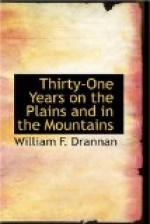They insisted on me accompanying them, and being anxious to cross over on the other side of the mountains, I agreed to join them. Having two saddle horses myself I told them three horses between them would be enough, for in case of emergency I would use one of my horses for a pack animal. The next two days were spent in getting ready for the trip, Mr. Damson, the wagon boss, having procured three horses for himself and Howard, Mr. Howard thinking it might not be conducive to his health to leave the Fort to look for horses.
Getting everything in readiness, we made the start just at dark, going the Emigrant canyon route, striking Echo canyon fifty miles from Salt Lake City, making the trip that far without stopping to let our horses feed or even to eat anything ourselves. We did this because we wished to get beyond the Mormon settlements without being discovered by them. We reached Fort Bridget the third day and there took in two more companions, John Scudder and John Korigo, who had been at work at the Fort all winter hauling wood for the Government. They had earned a little money and were returning to their respective homes, one living in Missouri and the other in Pennsylvania. We were now five in number and calculated to make Fort Kearney in fifteen days, which, if I remember rightly, is called six hundred miles from Fort Bridger.
We crossed Green river and took the Bitter creek route, thinking that would be the safest from hostile Indians; but when we got to the head of Bitter creek the Pony Express rider informed us that the Indians were very bad on the North Platte river, having killed two express riders the week before.
This frightened the boys badly, for not one of them had ever been engaged in an Indian fight, and all were free to admit that they were not hankering after experience of that kind.
After we struck North Platte we saw considerable Indian sign every day, but it was evident that the reds were in little bands.
From now on we made a dry camp every night, always stopping in the middle of the afternoon to let our horses graze while we did our cooking to avoid building our fire after dark. Then we would mount and ride until after dark and make a dry camp. This was done in order to avoid an attack while in camp, but we made the entire trip without seeing an Indian.
On my arrival at Fort Kearney I met my old friend Jim Bridger, who was waiting there for a man by the name of Jim Boseman, who was on his way with a large train of emigrants to the eastern part of Montana, the same country that Bridger, Kit Carson, Beckwith and I passed through in 1856 when the Indians were so bad.
Jim Bridger had met Boseman the fall before and had promised to pilot him through to that part of Montana, for which he was to receive five hundred dollars, it also being understood that, there would be at least fifty men in the train and all well armed.
Bridger was just in receipt of a letter from Boseman stating that he would be there on or about a certain date with two hundred men, most all of whom had families.




